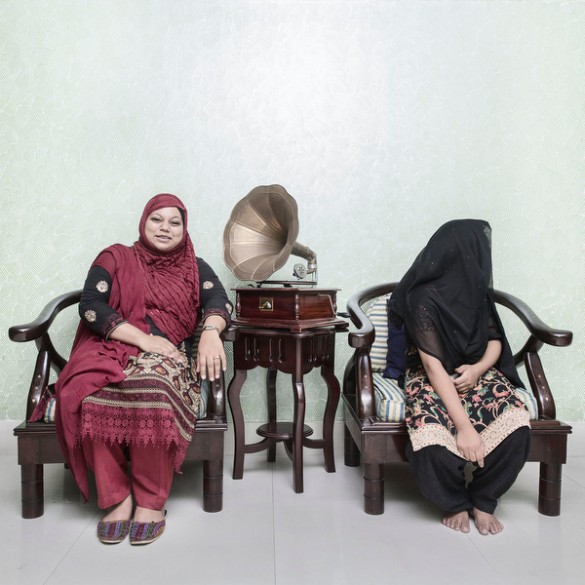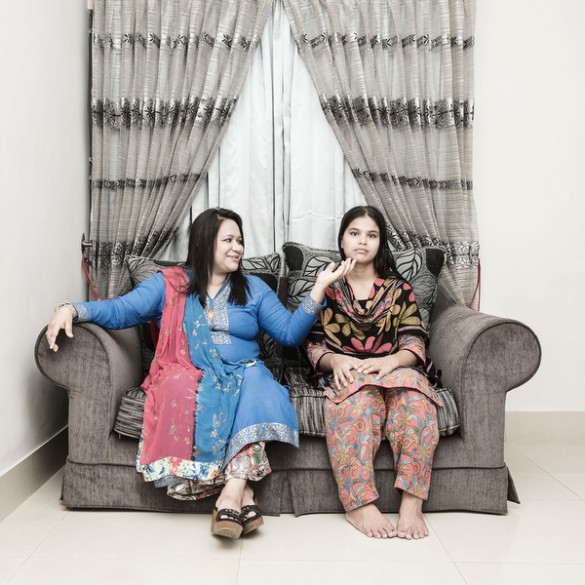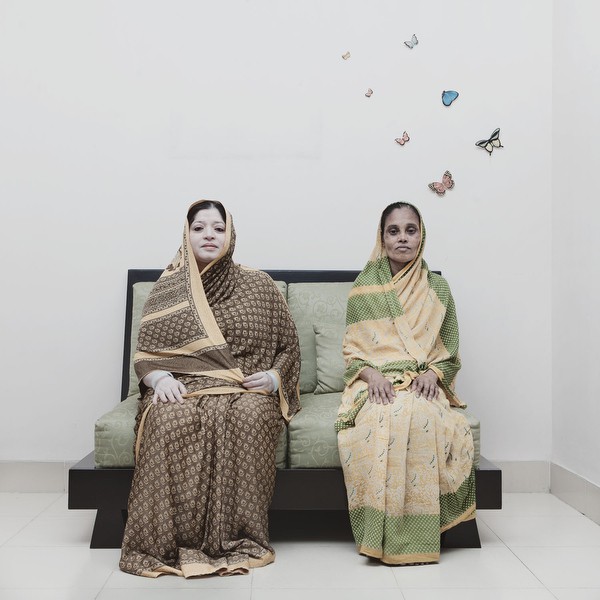
Close Distance, by Jannatul Mawa. 28 years Shakila Zaman Eshita is an Admin and HR Director, living in Niketon, Dhaka. Momena(Right), 15, a housemaid, staying in this house for 4 months to feed herself and family. Keeping help is a common scenario among middle and upper classes in Dhaka.
Jannatul Mawa: Invisible Boundaries and Class Dynamics
One of my favourite works from Bangladesh is ‘Close Distance’ by female photographer Jannatul Mawa. Mawa created ‘Close Distance’, typological portraits of middle-class housewives and their domestic helpers, especially for her community and others in privileged positions in Dhaka’s educated middle-class, but audience can be found beyond Bangladesh’s shores in countries like Hong Kong and Singapore where domestic help and class dynamics are commonplace.
In a recent Q&A with Mawa for an upcoming photo festival, she shares more insight on her motivations and photography.
On Beginnings
Mawa: “I was once actively involved in left-wing politics. In the process of doing politics, I needed to take a job where I had diverse roles in various agencies. It included women’s rights work with International NGOs. However, I had to adapt to the approach, strategy, nature and kinds of roles of the agencies I had to work with. To meet the needs of the job, I had to live in rural areas for several years. When I returned to Dhaka to my family, I felt I did a lot for others in a manner in which I had to follow their ways. After that, I wanted to work in my own way. I wanted to use the medium of cinema to communicate what I had to say. To set things in motion, I entered Pathshala South Asian Media Academy to learn photography. Gradually, I started to love the medium of photography. It seemed to to me that photography was a very important medium through which I could express my opinion-perspective, philosophy, and aspirations.”

Close Distance, by Jannatul Mawa. 36 years Fatima Rupa is a housewife, living in an upper class place, Jahanara Garden, Dhaka. 16 years old Shuroma (Right), is a housemaid who is living in the same family for last 25 years to feed her family. Keeping help is a common scenario among middle and upper classes in Dhaka.
On Close Distance
“Starting from my childhood till now, I have observed the lives of domestic helps – their work, what they give and how they are treated. As I grew up, my observation and reflection led me to think of them. Hiring housemaids is common amongst the urban middle class in Dhaka city. These domestic helps work from dawn to dusk for us. While they give us all kinds of comfort, do we care about them? Do we worry about when they eat, when they go to bed? How humanely do we treat them? As members of the educated middle class, as progressive human beings, do we talk about them? Do we mobilize public opinion so that they should have a day off, or think about whether they should get minimum wages? I wanted women house owners and domestic aides to sit together in order to raise these questions. Usually, we do not sit with them on the same sofa. Spatially we are very close, in the sense that we live in the same space but due to deep class differences, house owners and housemaids maintain strict invisible boundaries. These are physical and ideological. I wanted to explore that through my photography.”

Close Distance, by Jannatul Mawa. 57 years Anjumanara is a housewife, living in a middle class place, Green Road, Dhaka. 50 years old Jibonunneesa(Right), a housemaid, living in the city for last 10 years to feed her family. Keeping help is a common scenario among middle and upper classes in Dhaka.
On Approach and Perceptions
“I knew that people may perceive my work personally. So, I explained to the house owner about what I wanted to do and the purpose of my work. I clarified that it’s not a personal issue rather a social problem, and it needs to be overcome. People who agreed, sat on the same sofa. Seeing the pictures, many audiences in the exhibition thought that the house owners, who are privileged, are perhaps oppressive towards their housemaids. But it’s not like that. Usually, domestic helps are not allowed to sit together although they assist house owners in domestic work. I am very grateful to both house owners and the helps for having agreed to be photographed. Particularly to the house owners, because only they had the power to say ‘no.’
View Slideshow: Photo Essay: Close Distance, by Jannatul Mawa
More from Jannatul Mawa: https://mawaspace.wordpress.com
Share

